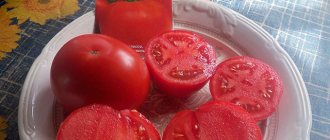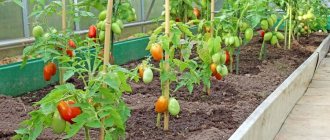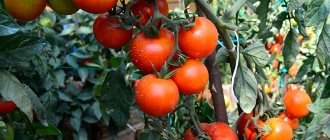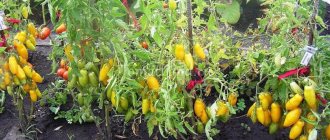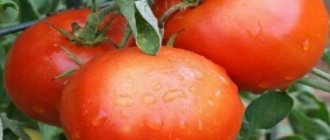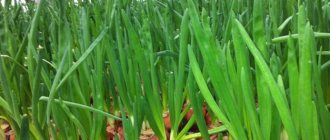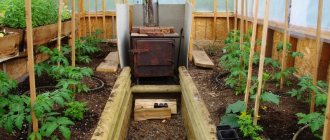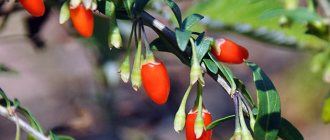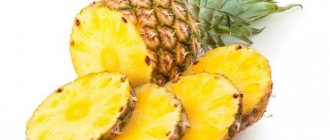Description of the Kaspar tomato
Tomato Caspar F1 is a determinate hybrid. Dutch breeders were involved in its breeding. They did not have time to register the variety in the State Register of Russia. It was improved, and in 2015 the Caspar 2 F1 tomato was registered. The differences between the varieties are insignificant: the first of them produces a harvest a little earlier than the second.
The website of the creator of the variety states that the bush can reach a maximum of 0.5 m in height; in practice, it most often grows above 0.8 m. The record height of the plant is 1.4 m.
This type of tomato is characterized by the presence of a large number of leaves. The foliage is large in size and colored bright green. The tomato has a thick and strong stem that can support a large amount of harvest.
The inflorescence of the variety is simple. It appears above the eighth leaf, and then alternates every one or two leaves. Caspar tomato inflorescences have a rich yellow color.
This variety of tomato is early ripening. Vegetables ripen approximately 3 months after the first shoots appear.
Description of fruits
According to the description of the variety, Caspar F1 tomatoes have an elongated cylindrical shape, like a sweet bell pepper. The vegetables are quite dense. Their weight can vary between 90-120 g.
Young tomatoes have a light green color, which turns into bright red as the plant develops. The fruits are characterized by a thick and dense skin, which allows them to be stored for a long time and transported over long distances.
Caspar tomatoes are small-chambered. They have 2 or 3 slots. Tomatoes have a pleasant taste and aroma. They have a slight sourness.
How to grow seedlings
Sowing of seeds is carried out no earlier than 60 days before planting in open ground. Only in this case can you grow beautiful, healthy, but not overgrown seedlings.
Seed preparation
Hybrid seeds do not require culling. However, it will not be superfluous to disinfect the seed material.
There are several options for this procedure:
- Place the seeds placed in a gauze bag into a weak solution of potassium permanganate;
- soak the seeds in the Fitosporin solution;
- soak the seeds in a soda solution (a teaspoon of soda per glass of water) - this procedure will not only destroy pathogens, but will also speed up the emergence of seedlings.
After disinfection, it is recommended to immerse the seeds in a growth stimulator for a day.
How I grow tomato seedlings
Watch this video on YouTube
Container and soil
Ready-made store-bought soil for indoor plants is suitable for growing seedlings. You can also prepare the soil mixture yourself.
To do this you will need the following components:
- peat;
- compost or humus;
- turf or leaf soil;
- sand (it is best to take river sand - it is coarser).
To 10 liters of soil mixture add a glass of wood ash (can be replaced with crushed chalk), as well as a tablespoon of mineral fertilizers. All ingredients are thoroughly mixed.
The substrate also needs to be disinfected. To do this, place it in the oven preheated to 100°C for 60 minutes.
As a container for planting, it is best to choose peat pots, tablets or special boxes and cassettes for seedlings.
Sowing
Small holes are made at the bottom of the planting container. After this, soil is poured there. Seeds are planted in the soil to a depth of 1 cm, with a distance between seeds of 3 cm. 3–6 seeds can be placed in peat pots, and 2–4 in tablets.
It is better to spill the soil with water in advance so as not to wash out the seeds with a stream of water. The containers are covered with film or glass and placed in a warm room. The optimal temperature for seeds is 28–30°C.
Every day the film is opened for a few minutes. When the first sprouts appear, it is removed.
Growing and caring for seedlings
With the appearance of the first shoots, the seedlings are transferred to a cool place with a temperature of 16–18°C. After 7–10 days, the sprouts are transferred again to a warm place with a temperature of 20–22°C; at night it should be cooler – 14–16°C.
Rules for caring for seedlings:
- Watering. The roots of tomato seedlings are delicate, so water the sprouts carefully, along the edges of the container; use a watering can without a nozzle. It is also necessary to spray the plant once a day, twice on dry days.
- Lighting. Young sprouts require a lot of light, so it is recommended to place the seedlings on a southern windowsill or loggia. If there is a lack of natural light, a phytolamp is used. The containers are rotated periodically so that the plants do not pull in one direction.
- Dive. If the seedlings are located too densely, they need to be planted immediately after the first leaves appear. The sprouts are transplanted to a depth of 3-4 cm with a distance between them of 5–7 cm. The seedlings are planted together with a lump of earth. After 20–22 days, repeat diving is carried out in a larger container.
- Feeding. 15–20 days after the first shoots, the seedlings are fed. Feeding is carried out regularly, every 10 days. You can choose ready-made complex fertilizers, or you can take wood ash, eggshells or chicken droppings.
Characteristics of the variety
According to the description, Caspar tomatoes (shown in the photo) have good characteristics. The culture has virtually no disadvantages. It produces excellent yields, has a wide range of uses, and is also resistant to the most common diseases, making the variety an ideal option for beginners in the field of growing vegetables.
Productivity and fruiting
In reviews of Kaspar tomatoes (pictured), many summer residents praise the crop for its long-term fruiting and very high yield. The plant is literally covered with tomatoes. One bush can produce approximately 1.5 kg of vegetables.
The crop can be grown both in a greenhouse and in open ground. Tomato ripening takes approximately 3 months.
Area of application of fruits
Due to the size and shape of this type of tomatoes, they are a good option for canning. If you look at the reviews, you will notice that many recommend using Kaspar F1 tomatoes for cooking in their own juice. In addition, vegetables can be used as an ingredient in stews, soups, sauces and juices. Tomatoes go well with meat dishes.
Resistance to diseases and pests
The Caspar tomato variety is immune to various diseases and fungi that often affect other varieties of tomatoes. A characteristic feature of this species is resistance to insect pests.
Advantages and disadvantages of the variety
Caspar tomatoes have many positive qualities, which include characteristics such as:
- a large amount of harvest;
- immunity to diseases;
- resistance to insect pests;
- short ripening periods;
- possibility of long-term storage;
- attractive appearance;
- unusual shape;
- uniform ripening;
- possibility of transportation over long distances;
- versatility of use;
- good taste;
- pleasant aroma;
- Possibility of growing both in open soil and in a greenhouse.
As you can see in the reviews, many summer residents attribute the sour taste of its fruit to the disadvantages of the Caspar variety tomato. No significant disadvantages were noticed with this variety.
Advantages and disadvantages
The Caspar hybrid has many advantages that allow it to be very popular among gardeners:
- One of the most unpretentious tomatoes to grow.
- A high-yielding variety - you can harvest 1.5-2 kg of tomatoes from one bush.
- Does not require mandatory pinching and plenty of space for growing.
- The tasty fruits ripen quite early.
- Ideal for canning, especially in its whole form.
It also has some disadvantages:
- Tomatoes of this hybrid are quite susceptible to blossom end rot. This must be taken into account at the stage of growing seedlings.
Blossom rot on Kaspar tomatoes
- It is a hybrid - there is no point in collecting seeds. You'll have to buy new ones every year.
Growing rules
In order for the Caspar tomato variety to actively grow, develop and delight the owner with an abundant and high-quality harvest, it is necessary to follow certain rules for growing and caring for the plant.
Planting seedlings
Attention!
Caspar tomatoes are grown using the seedling method. Before planting seeds of this variety for seedlings, carry out the following preparatory steps:
- Disinfect the seeds. If they were purchased at a garden store, then there is no need to carry out the disinfection procedure. Otherwise, the material should be soaked in a special solution. This can be a manganese (1 g per 100 ml of water) or soda (0.5 g per 100 ml of water) solution. You can use aloe juice diluted with water (1:1).
- Soil disinfection. If the soil was not purchased at a garden store, it also needs to be disinfected. To do this, heat it in the oven (at 190°C for 10 minutes) or in the microwave (at 850 power for 2 minutes). The soil can be disinfected using boiling water or potassium permanganate.
Once the seeds and soil are disinfected, you can begin planting. This should be done at the end of March. To plant, you need to fill the container (made of peat, plastic or wood) with prepared moist soil. You need to dig small 1-centimeter grooves in it, the distance between which is at least 3 cm. There should be about 2 cm between the tomato seeds. After this, the grooves are sprinkled with soil.
The container is covered with glass or film material. The seedlings should be kept in a room with a temperature of about 25°C.
When the soil begins to dry out, it is generously sprayed with a spray bottle. If the soil is excessively moist, you need to remove the glass or film for a while to let it dry.
Transfer
Important! Caspar tomato seedlings should be transplanted into open soil at the end of May. It can be moved to the greenhouse a little earlier (late April - early May).
The soil for growing tomatoes must be air and water permeable. It should be prepared in the fall. To do this, the soil must be well fertilized. You can use compost, eggshells and ash.
Advice! For 1 sq. No more than three young shoots should be placed.
If you plant them closer, this will have a bad effect on the fruiting of the Caspar tomato variety. It will produce less yield, and the quality will also suffer.
Before planting, the soil must be loosened. 10 g of superphosphate should be placed in the prepared recesses.
After planting the seedlings, the soil should be watered generously with settled water at room temperature.
Aftercare
Caspar tomatoes are an unpretentious variety. The main measures for caring for the crop include moistening and loosening the soil, weeding, removing shoots and mulching.
During the development of the tomato and before fruiting begins, it must be fed with fertilizers that contain minerals (for example, phosphate and potassium). The first feeding should be carried out after the formation of the ovary, after equal periods of time the procedure should be repeated 2-3 more times.
Useful video
We invite you to familiarize yourself with the options for growing tomatoes of the Caspar F1 variety in boxes:
In the table below you will find links to tomato varieties that ripen at different times:
| Super early | Mid-season | Mid-early |
| Leopold | Nikola | Supermodel |
| Shchelkovsky early | Demidov | Budenovka |
| President 2 | Persimmon | Major F1 |
| Lyana Pink | Honey-sugar | Cardinal |
| Locomotive | Pudovik | Bear Paw |
| Sanka | Rosemary pound | King Penguin |
| Pickling miracle | Beauty King | emerald apple |
How to grow tomatoes
After 50–55 days, the seedlings are transplanted into open beds. If possible, the tomato bed is located in a sunny place, protected from the wind.
Planting pattern: 50 cm – distance between plants; 40 cm – row spacing.
For 1 sq. m place up to 6 bushes, since the plants are compact and low-growing.
A week after transplantation, the tomatoes are watered and fed with organic or mineral fertilizers. An infusion of mullein is suitable as an organic substance; it is used in a dilution of 1:15 so as not to burn the root system.
Tomato loves abundant watering, once every 7-10 days.
After watering, the soil is loosened, hilled up and weeds with roots are removed. Mulching helps keep the beds moist longer.
Culture needs obligatory garter
Stepchildren are removed only up to the first brush. The maximum fruiting rate is observed when the plant forms several stems. In open ground the crop is grown in 4-5 stems, in a greenhouse it is formed in 3-4 stems.
Feed twice during the entire growing season. Organic or complex mineral fertilizer containing nitrogen, phosphorus and potassium is fed during mass flowering. During ripening, fertilizing is carried out, consisting of phosphorus and potassium fertilizers. This technique improves the taste of tomatoes, making them sweeter and more aromatic. While the fruit is pouring, stop watering and loosening the soil.
Diseases and pests
Despite the resistance to various diseases embedded in the genes, the tomato sometimes turns out to be powerless against infections and pests. Sometimes, even with proper and timely care, summer residents complain about crops being damaged by one or another disease, blaming low-quality seeds, stupid sellers and, in general, the whole world, in which there are only Colorado potato beetles, mole crickets and various molds. But this is the law of Nature, natural selection, which forces pests to adapt even to the strongest organisms in order to survive themselves.
Powdery mildew affects crops in a greenhouse. The leaves become covered with a white coating, wither and fall off. The following drugs help to cope with it: “Quadris”, “Topaz” and sodium humate (1 g per 1 liter of water).
Anthracnose is a fungal disease. Leaves and fruits suffer. The foliage withers, falls, vegetables become covered with brown spots. Drugs will help in the fight against it: “Oxychom” or copper sulfate.
The main cause of fungal diseases is high humidity
A dangerous pest of tomatoes is the gnawing cutworm. This butterfly itself is not dangerous, but its caterpillars feed on plants and fruits. To prevent egg laying, the crop is treated with wormwood infusion with the addition of ash and liquid soap.
The Colorado potato beetle and slugs eat the leaves and actively reproduce. The larvae and insects themselves are collected by hand. To prevent slugs, tobacco is sprinkled around the plants. They are also good at the smell of beer, so they set up traps for slugs by pouring a little beer into them.
Care requirements
All further care for tomatoes comes down to several activities. In the first few days, Caspar F1 tomatoes need protection from the sun and cold. Therefore, at midday they are covered with agrofibre or burlap, and at night - with film.
Watering
Systematic moistening promotes good growth and high-quality fruiting. The first watering is carried out a week after transplanting the tomatoes into the garden. All subsequent ones - as the earth dries out. Watering will be mandatory at the beginning of flowering and at the stage of fruit filling, which will increase the number of flowers and ovaries.
After each watering, the soil is loosened and weeds are removed. Each stem is mulched with peat or garden soil to protect it from lodging, and the roots from drying out.
Feeding
Plants need to be fertilized
The description of the Caspar F1 tomato includes high productivity, provided good nutrition. Tomatoes need to be fed 3 times throughout the entire season.
The first fertilizer with a urea solution (1 tablespoon per bucket of water) is applied 20 days after transplanting the tomatoes into the garden bed. 200 ml of working solution is poured under each plant. The second time, the crop is fertilized with mineral fertilizers (superphosphate with potassium salt - 15 g per 10 liters of water). Consumption per plant – 0.5 l.
The same fertilizer and in the same quantity is applied at the stage of fruit filling. Additionally, the bushes are irrigated with a solution of boric acid (0.2 g per 1 liter of hot water). Tomatoes are sprayed before flowering and a week after the flower buds dry out. Boron improves the quality of fruiting and immunity against diseases.
Garter and shaping
This plant does not need to be formed, but to obtain larger fruits it is recommended to pinch all shoots and leaves at the bottom of the bush. For stability and protection from stems breaking off under the weight of the fruit, a garter is applied as the stem grows.
Humidity and temperature
Greenhouse plants need to be provided with good ventilation and stable heat within 20-23 °C. To do this, you need to carry out frequent ventilation on sunny days in the morning. On hot days, the windows can be left open all day until the evening.
Prevention of diseases and pests
The plant is resistant to diseases, but gentle prevention will not hurt it. 3 weeks after transplanting into the garden, the tomatoes are treated with the preparation “HOM”, “Skor” or a solution of copper sulfate, Bordeaux mixture. The same products are used for re-treatment before flowering.
The following measures will help against parasites: timely removal of weeds, sprinkling with ash or ground hot pepper. If insects appear, it is necessary to spray the tomatoes with an ash-soap solution or an infusion of onion and garlic.
To protect greenhouse plants from various types of rot, you should follow the rules of watering - avoid waterlogging, loosen the soil between the rows, remove plant debris and weeds in a timely manner.
If tomatoes are damaged by diseases during the fruiting phase, treatment is not carried out, because fruits can absorb chemicals and become unfit for consumption.
Infected tomatoes are immediately removed from the site to avoid infection of healthy bushes. The places where they grow are irrigated with a concentrated solution of potassium permanganate or copper sulfate.
